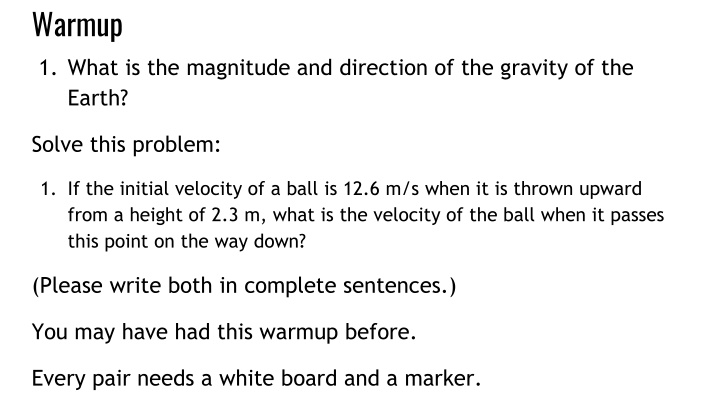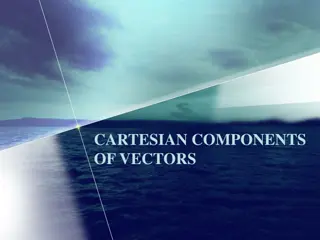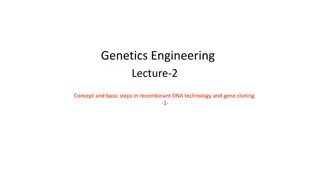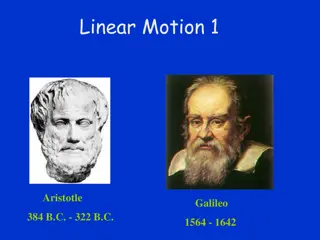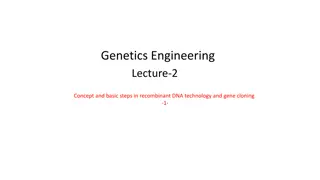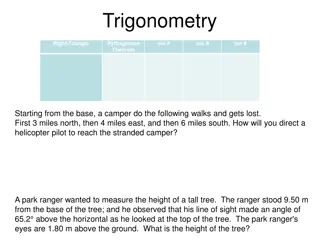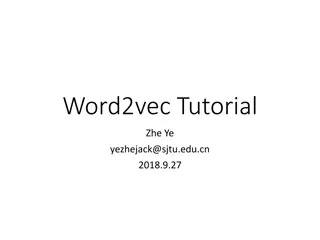Introduction to Vectors and Scalars in Physics
Explore the concept of vectors and scalars in physics through a series of warm-up exercises, quizzes, and group problems. Understand the differences between quantities with magnitude and direction versus those with magnitude only. Practice solving problems involving velocity, displacement, and more to enhance your understanding of symbolic relationships in physics.
Download Presentation

Please find below an Image/Link to download the presentation.
The content on the website is provided AS IS for your information and personal use only. It may not be sold, licensed, or shared on other websites without obtaining consent from the author.If you encounter any issues during the download, it is possible that the publisher has removed the file from their server.
You are allowed to download the files provided on this website for personal or commercial use, subject to the condition that they are used lawfully. All files are the property of their respective owners.
The content on the website is provided AS IS for your information and personal use only. It may not be sold, licensed, or shared on other websites without obtaining consent from the author.
E N D
Presentation Transcript
Warmup 1. What is the magnitude and direction of the gravity of the Earth? Solve this problem: 1. If the initial velocity of a ball is 12.6 m/s when it is thrown upward from a height of 2.3 m, what is the velocity of the ball when it passes this point on the way down? (Please write both in complete sentences.) You may have had this warmup before. Every pair needs a white board and a marker.
Quiz Go over quizzes! I told you to write the list, the formula, the work with units, and the answer with units!!
Introduction to Vectors Unit 3
Objective To express and interpret relationships symbolically to make predictions and solve problems mathematically, including problems requiring proportional reasoning and graphical vector addition.
Scalars and Vectors Vectors have magnitude and direction. Scalars only have magnitude.
Questions Which of the following quantities are scalars, and which are vectors? 1. the acceleration of a plane as it takes off 2. the number of passengers on the plane 3. the duration of the flight 4. the displacement of the flight 5. the amount of fuel required for the flight
Vectors A resultant vector represents the sum of two or more vectors.
Group Problem: A truck driver is attempting to deliver some furniture. First, he travels 8 km east, and then he turns around and travels 3 km west. Finally, he turns again and travels 12 km east to his destination. 1.What distance has the driver traveled? 2.What is the driver s total displacement? First, sketch the distances. Add the numbers. (magnitude) Add the displacement.(magnitude and direction)
Group Problem: A truck driver is attempting to deliver some furniture. First, he travels 8 km east, and then he turns around and travels 3 km west. Finally, he turns again and travels 12 km east to his destination. 1.What distance has the driver traveled? 2.What is the driver s total displacement? First, sketch the distances. Add the numbers. (magnitude) 23 km Add the displacement.(magnitude and direction) 17 km east
Vectors Vectors can be added graphically. A student walks from his house to his friend s house (a), and then from his friend s house to the school (b). The student s resultant displacement (c) can be found by using a ruler and a protractor.
Coordinate Systems 300 m/s northeast or 300 m/s at 45 NE
Pythagorean Theorem Right Triangles a2+ b2= c2 Tangent tangent ? = opposite adjacent ? = tan-1opp
Properties of Vectors Vectors can be moved parallel to themselves in a diagram. Vectors can be added in any order. Head to tail.
Problem A very smart physics student travels 115 m east, then 136 m north. What is his displacement? Calculate the displacement: a2+ b2= c2 c (115 m)2east + (136 m)2north = c2 b 13,225 m2+ 18,496 m2= c2 31,721 m2= c2 a 178 m = c
Problem A very smart physics student travels 115 m east, then 136 m north. What is his displacement? Calculate the angle: (set your calculator to degrees) After you put the vectors head to tail, draw the resultant vector. The angle you use is the one where the tails meet. c b tan ? = opp/adj ? = tan-1(136 m/115 m) a = 49.8 northeast
Group Problems While following the directions on a treasure map, a pirate walks 45.0 m north and then turns and walks 7.5 m east. What is the pirate s resultant magnitude, angle, and direction?
Group Problems While following the directions on a treasure map, a pirate walks 45.0 m north and then turns and walks 7.5 m east. What is the pirate s resultant magnitude, angle, and direction? 46 m northeast 9.5 northeast
Group Problems Emily passes a soccer ball 6.00 m directly across the field to Kara, who then kicks the ball 14.5 m directly down the field to Luisa. What is the ball s total displacement as it travels between Emily and Luisa? (magnitude, angle, and direction)
Group Problems Emily passes a soccer ball 6.00 m directly across the field to Kara, who then kicks the ball 14.5 m directly down the field to Luisa. What is the ball s total displacement as it travels between Emily and Luisa? (magnitude, angle, and direction) 15.7 m 22.5 down to side of field
Functions sin ? = opp/hyp cos ? = adj/hyp tan ? = opp/adj Soh Cah Toa
Group Practice Find the components of a helicopter traveling 95 km at an angle of 35 to the ground. 95 km y 1. Draw the vectors: 35 x 1. Choose an equation and rearrange the equation to isolate the unknowns. sin ? = opp/hyp tan ? = opp/adj
Group Practice A roller coaster travels 41.1 m at an angle of 40 above the horizontal. How far does it move horizontally and vertically?
Objective To express and interpret relationships symbolically in accordance with accepted theories to make predictions and solve problems mathematically, including problems requiring proportional reasoning and graphical vector addition.
Reflection How would we use these skills outside of school? (complete sentences)
